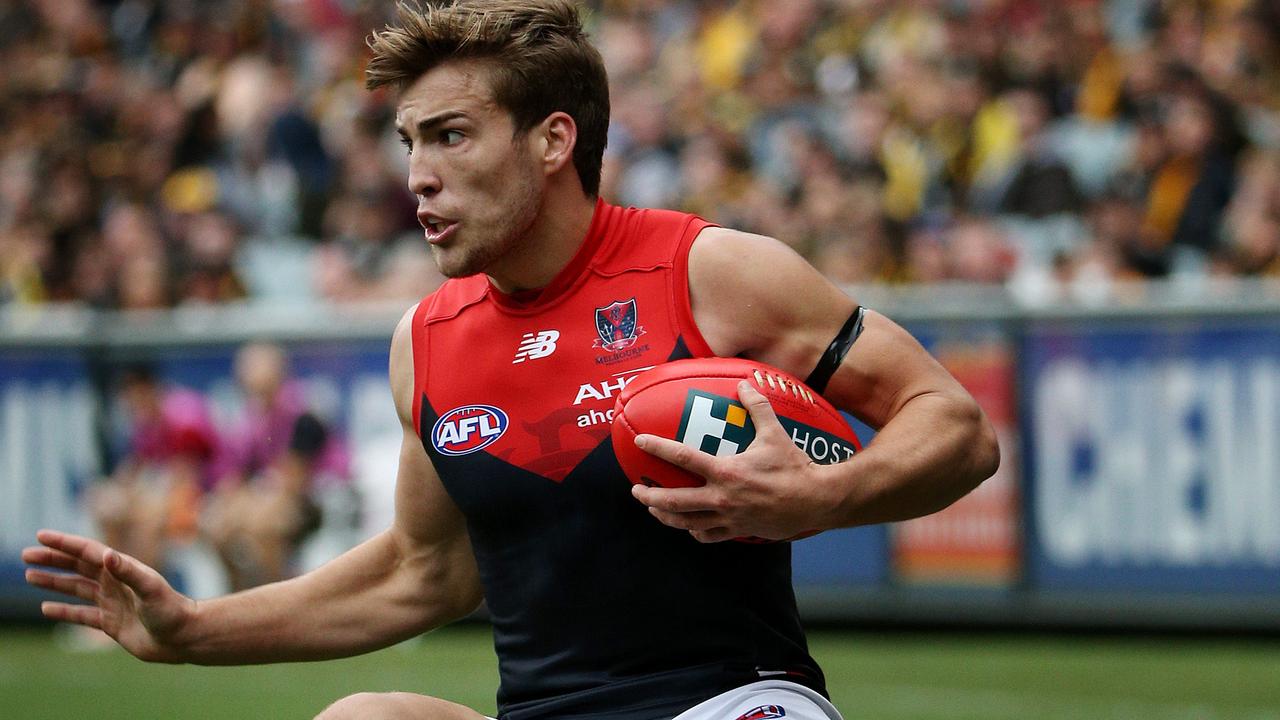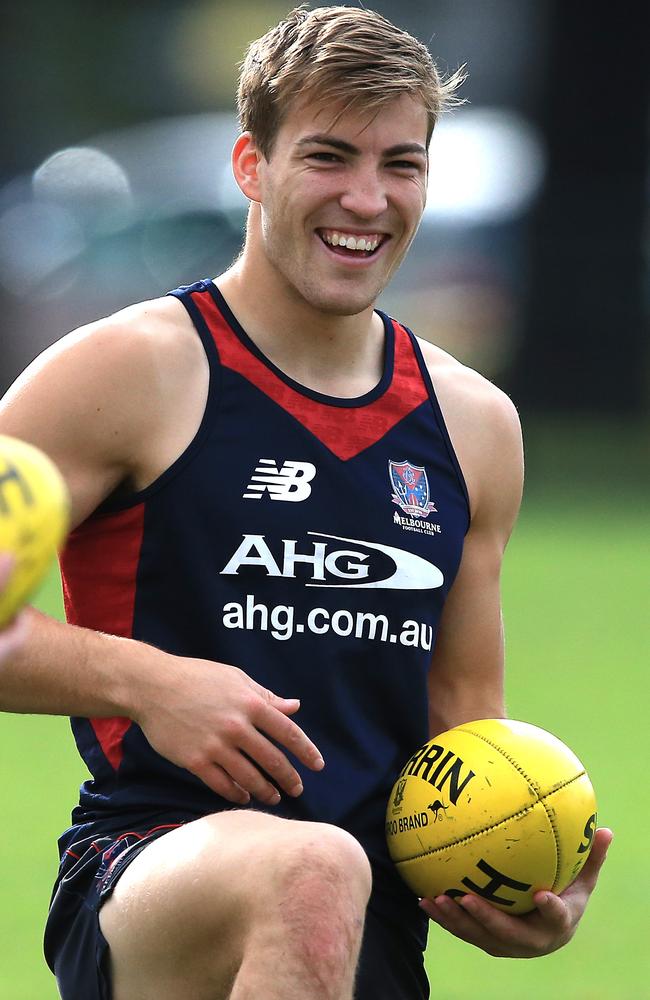AFL issues reasons behind why Melbourne midfielder Jack Viney won his appeal over bump ban
JACK Viney’s two-week ban was thrown out because he didn’t bump but instead braced for contact, according to the AFL Appeals Board.

JACK Viney’s two-week rough conduct suspension was thrown out because he didn’t bump Adelaide’s Tom Lynch but instead braced for contact, according to the reasoned decision by the AFL Appeals Board.
The decision, released today more than two weeks after the appeal was upheld, said it was unreasonable for the tribunal not to have taken into account Viney’s evidence “which resolved the issue of whether it was a bump or a brace” that broke the jaw of Lynch.
At the initial tribunal hearing Viney said: “Not at any stage was I trying to bump him, I was just trying to brace for impact”.
The appeals board noted that prosecutor Jeff Gleeson had not challenged him on that point.
“It was contended that it was open for the tribunal to conclude that Viney intended to and did bump Lynch, but that it was also open to find that Viney was bracing himself rather than bumping,” the appeals board wrote.
SCROLL DOWN TO READ ‘THE REASONS FOR THE DECISION TRANSCRIPT
“In that circumstance there should be a necessary doubt in the tribunal deciding that issue, as there is in an appeal board reviewing the evidence. “In that situation the alleged offender should have the benefit of that doubt. “For that reason alone the Board finds that the ground of appeal has been established.
“(Viney’s) evidence was that he had no intention of bumping and that he did not do so. This was not challenged in cross-examination by the highly competent and experienced Mr. Gleeson QC.

“The board finds that it would be unreasonable for the Tribunal or any other Tribunal to disregard or fail to take into account Viney’s evidence which resolved the issue of whether it was a bump or a brace in Viney’s favour. “For the above reasons the appeal was upheld.”
To win an appeal, it must be established that decision of the tribunal was “so unreasonable, that no tribunal acting reasonably could have come to that decision”.
Melbourne, the tribunal and the match review panel have all been given copies of the decision.
AFL Football Operations boss Mark Evans said after the Viney decision, it would be recommended to the match review panel that it look at incidents at full speed and not slow motion when it came to assessing the intention of players.
The appeals board said different camera angles of the incident gave different impressions of Viney’s intent.
“The relevant evidence before the tribunal on this issue is a multiplicity of video recordings, taken from various angles. That video evidence was consistent on the one hand with the action of the appellant constituting an intentional bump, and on the other, bracing to meet a collision with a player or players coming towards him at full pelt,” it said.
“Thus there were two equally competing versions of the facts, one which was innocent, and the other which was not.”
The two-match suspension was met with a wave of criticism from current and past players, as well as the AFL Players’ Association who warned the judgement had the potential to confuse players as to how they were to act in potentially dangerous situations on the ground.

REASONS FOR DECISION
1.(a) On 6 May 2014 the AFL Tribunal found that Jack Viney of Melbourne Football Club was guilty of “rough conduct on T Lynch of Adelaide Football Club in accordance with Rule 19.2.2 of the Laws of Australian Football. Consequently Viney was suspended for two matches.
(b) Viney appealed to the Appeals Board in respect of that decision. On 8 May 2014 the Board heard the appeal. Mr. Jeff Gleeson QC appeared as Counsel to assist the Board and Mr. David Grace QC appeared for Viney. Having heard the evidence and submissions the Board announced that the appeal would be upheld and that detailed reasons would be provided in due course. These are those reasons.
2. The Board considered that it was necessary to give reasons for its decision because of the importance of the case, the cogent and helpful submissions of Mr. Grace and Mr. Gleeson, and most importantly because the Board upheld the appeal from a conspicuously competent and experienced Tribunal.
3. The Board is conscious that in hearing this Appeal it can only do so “by way of a review of the evidence presented before the Tribunal and determine” if the ground of appeal has been established.
4. The Board was required to determine whether the Appellant had discharged the onus of establishing on the balance of probabilities, that the decision of the Tribunal was so unreasonable, that no Tribunal acting reasonably could have come to that decision.
5. It goes without saying that the Appellant had a heavy onus to discharge, which the Board was satisfied he had and unanimously found that the Appeal should be upheld.
THE ALLEGED OFFENCE
6. On 5 May 2014 the Match Review Panel (“MRP”) charged Mr. Jack Viney of Melbourne Football Club with “rough conduct on T Lynch of Adelaide Football Club contrary to Rule 19.2.2 of the Laws of Australian Football 2014”, (which reportable offence was allegedly committed in the first quarter during the match between Adelaide and Melbourne played at Adelaide Oval on 3 May 2014).
7. The MRP did not proceed to determine the charge, but as it was empowered to do, decided that “the Notice of Charge should be determined by the Tribunal without the player having the option to enter an early plea,” and duly notified the player (see Regulation 16.13(h) vi).
8. Thus the Tribunal had to determine whether the reportable offence of rough conduct had been made out. In determining that issue it was common ground that the Tribunal should also have regard to Regulations which relevantly provide:
“A player will be guilty of rough conduct where in the bumping of an opponent (whether reasonably or unreasonably) he causes forceful contact to be made with any part of his body to an opponent’s head or neck unless …..”
9. The crucial issue in this appeal therefore, was whether the Appellant engaged “in the bumping” of his opponent Tom Lynch.
10. `The relevant evidence before the Tribunal on this issue is a multiplicity of video recordings, taken from various angles. That video evidence was consistent on the one hand with the action of the Appellant constituting an intentional bump, and on the other, bracing to meet a collision with a player or players coming towards him at full pelt. It was contended that it was open for the Tribunal to conclude that Viney intended to and did bump Lynch, but that it was also open to find that Viney was bracing himself rather than bumping.
11. Thus there were 2 equally competing versions of the facts, one which was innocent, and the other which was not. In that circumstance there should be a necessary doubt in the Tribunal deciding that issue, as there is in an Appeal Board reviewing the evidence. In that situation the alleged offender should have the benefit of that doubt. The Board found that it would be unreasonable for the Tribunal or any other Tribunal, not to afford the benefit of that doubt to the Player and dismiss the charge. For that reason alone the Board finds that the ground of appeal has been established.
12. But there is another important factor justifying the above finding, and that is the evidence of Viney. His evidence was that he had no intention of bumping and that he did not do so. This was not challenged in cross-examination by the highly competent and experienced Mr. Gleeson QC.
13. The Board finds that it would be unreasonable for the Tribunal or any other Tribunal to disregard or fail to take into account Viney’s evidence which resolved the issue of whether it was a bump or a brace in Viney’s favour.
14. For the above reasons the Appeal was upheld and Viney’s suspension set aside.
Originally published as AFL issues reasons behind why Melbourne midfielder Jack Viney won his appeal over bump ban



